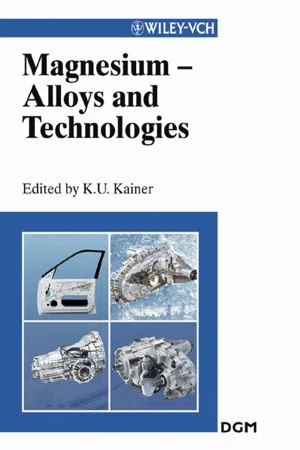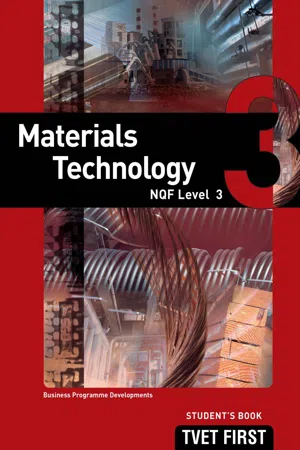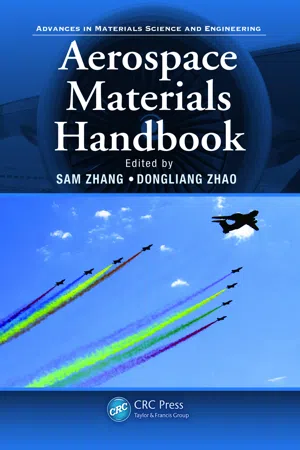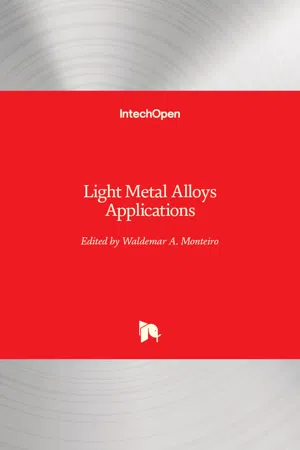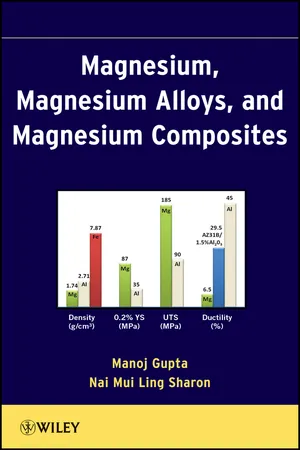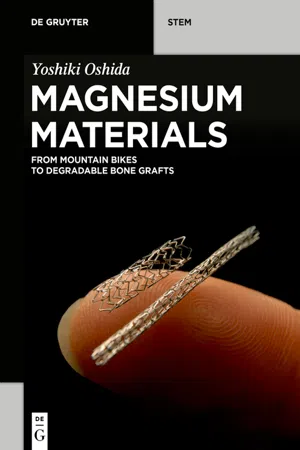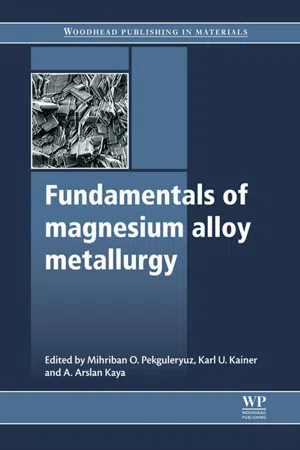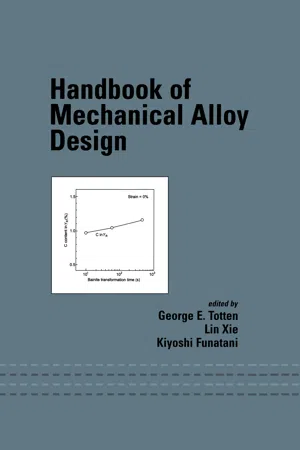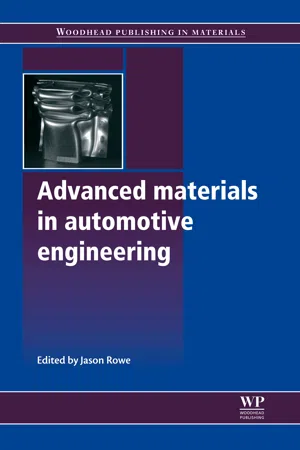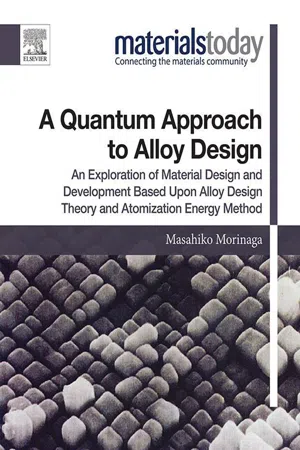Technology & Engineering
Magnesium Alloys
Magnesium alloys are metal alloys composed primarily of magnesium along with other elements such as aluminum, zinc, and manganese. They are known for their lightweight and high strength-to-weight ratio, making them valuable in applications where weight reduction is critical, such as in the automotive and aerospace industries. Magnesium alloys also exhibit good machinability and damping capacity, contributing to their versatility in engineering applications.
Written by Perlego with AI-assistance
Related key terms
1 of 5
12 Key excerpts on "Magnesium Alloys"
- eBook - PDF
- Karl U. Kainer(Author)
- 2006(Publication Date)
- Wiley-VCH(Publisher)
The negative properties mentioned above deter construction engineers from accepting mag- nesium alloys as a competitive replacement for aluminium or steel. Therefore, attempts have been made to improve the characteristic profile of Magnesium Alloys by employing different alloying elements so as to achieve better precipitation and solid-solution hardening. In this way, all the advantageous properties listed below have been realized: • lowest density of all construction metals at 1.8 g/cm 3 ; light construction parts possi- ble • high specific strength (strength/density ratio) • excellent casting ability; steel dies may be used • good machining ability (milling, turning, sawing) [4] • improved corrosion resistance with high-purity (HP) alloys [5] • high damping properties • good weldability under inert gases • integrated recycling possible The static and dynamic mechanical properties are inferior to the corresponding values for the competing aluminium, e.g. the Young’s modulus. Nevertheless, magnesium is found in all places where weight saving takes priority over the other properties, mainly because the specific strength can reach and even exceed the values for aluminium and steel. Figure 1: Densities and specific strengths of selected materials 1.3 Alloying Systems To give a short overview of the different Magnesium Alloys, it is necessary to first show the identification of all kinds of alloys and the effect of each alloying element. 4 The Current State of Technology and Potential for Further Development of Magnesium Applications 1.3.1 Identification of Magnesium Alloys The identification of Magnesium Alloys is standardized worldwide in the ASTM norm; each alloy is marked with letters indicating the main alloy elements, followed by the rounded figures of each (usually two) weight in percentage terms. Table 2 shows the key letters for every available alloying element. - eBook - PDF
Materials Technology NQF3 SB
TVET FIRST
- Business Programme Development (PTY) Ltd(Author)
- 2013(Publication Date)
- Macmillan(Publisher)
But lead by itself is not poisonous. Do research to find out what makes lead poisonous for people and the environment. Find out what measures have been taken to deal with this issue. At the end of this unit, you will be able to: • describe the effect of alloying on the physical properties of Magnesium Alloys. Pure magnesium is the lightest metal used to build things. However, because it does not have enough strength on its own for structural purposes, it must be alloyed with other alloying elements. These alloying elements include aluminium, zinc, zirconium and thorium. The Germans pioneered the use of magnesium in aircraft parts during World War II. • Light weight and low density: The aerospace industry has traditionally driven the development of Magnesium Alloys because they need lightweight materials. Magnesium Alloys have low density, only two thirds that of aluminium. This has been a major factor in the widespread use of magnesium alloy castings and wrought products. The strength to weight ratio is very high and resembles that of high-tensile steel. • Corrosion resistance: Magnesium Alloys also have excellent corrosion resistance. • Machinability: Magnesium is the lightest of all machinable metals. No metal can be cut, drilled or shaped as easily. This helps to reduce the cost of the final product. • Versatility: Magnesium Alloys can be processed in all the usual ways including casting, die-casting, rolling, forging, extruding and pressing. Casting characteristics are excellent because the molten metal has a low heat content and low viscosity. Magnesium Alloys have limited cold-forming capabilities, but they are readily hot-worked at temperatures ranging from 150 to 400 C. Figure 3.5 The main advantage of Magnesium Alloys is lightness so they are used in racing cars and the aerospace industry Alloying elements originally used to harden magnesium were aluminium and zinc. A small amount of manganese was used to improve corrosion resistance. - eBook - PDF
- Sam Zhang, Dongliang Zhao, Sam Zhang, Dongliang Zhao(Authors)
- 2016(Publication Date)
- CRC Press(Publisher)
609 Preparation and Processing of Magnesium Alloys Magnesium Alloys include the AZ series (Mg–Al–Zn), AM series (Mg–Al–Mn), AE series (Mg– Al–RE), EZ series (Mg–RE–Zn), ZK series (Mg–Zn–Zr), and WE series (Mg–RE–Zr)), advanced preparation (such as rapid solidification, powder metallurgy, die casting, etc.), and processing tech-nology (like ECAP, high-speed rolling, cross rolling, etc.) are developed, which greatly promotes the application prospects of Magnesium Alloys in aerospace. 12.2 BRANDS AND CLASSIFICATION OF Magnesium Alloys The application of pure magnesium as a structural material is rare. Alloying elements, such as alu-minum, zinc, manganese, zirconium, RE (rare earth), cerium, silver, and so on, are usually added into the base materials to modify the mechanical properties as well as the corrosion performance. Solid solution hardening and/or precipitation hardening are the key mechanisms to enhance the mechanical properties. In Section 12.2.1, the effects of alloying elements on mechanical properties and the main alloy systems are briefly discussed. 12.2.1 E FFECT OF A LLOYING E LEMENTS 12.2.1.1 Aluminum Aluminum is one of the most commonly used alloying elements in magnesium. The main functions of Al can be concluded as follows: first, the formation of intermetallic phase Mg 17 Al 12 phase can enhance the hardness and strength. The Mg–Al alloy with Al more than 6 wt.% can be heat treated. With the aluminum content increase, stress corrosion becomes serious. In addition, the aluminum can also broaden the solidification range to improve the casting properties (Avedesian and Baker 1999, Gupta and Sharon 2011). FIGURE 12.1 Magnesium applications in aerospace industry. (a) Monocoque wing aircraft all made of magnesium; (b) missile containing Mg-sheet of about 18 kg; (c) helicopter with Mg-sheet of about 113 kg; (d) vanguard satellite launching rocket containing tail can, 2 n stage skin in spacer section and satellite skin made of magnesium. - eBook - PDF
- Waldemar A. Monteiro(Author)
- 2014(Publication Date)
- IntechOpen(Publisher)
Magnesium Alloys are employed as a replacement for plastics when require adequate thermal conductivity properties. This makes Magnesium Alloys a better choice in electronic appliances to dissipate heat generated by electronic circuits. These alloys are utilized within TVs, LCDs and PC casings. There are many other better magnesium alloy properties. Magnesium Alloys are less resistant to cutting, which makes them easier for rapid machining. The Mg alloys are superior at electromagnetic interference (EMI) shielding and often used in casings for mobile phones. Magnesium Alloys are easily recyclable, ductile and can absorb vibration well. Magnesium Alloys also have excellent resistance to corrosion. The alloys resist dents and are less likely to give dents to other metals [3-5]. Magnesium is the perfect material for applications where weight saving is a precedence, as it has the lowest density of all structural metals. Almost as light in weight as plastic, magnesium has the advantage of greater strength and rigidity, along with inherent EMI shielding and full recyclability. The magnesium benefits are: the lightest of all structural metals; excellent stiffness & strength-to-weight ratio; exceptional EMI shielding properties; high electrical and thermal conductivity; withstands high operating temperatures; cost effective versus many engineered thermoplastic materials; high dimensional accuracy and stability; exceptional thin-wall capability; good environmental corrosion resistance; good finishing characteristics; fully recyclable, all of these, ideal for electronic devices [6-8]. 2. Elements in magnesium There are several magnesium compositions which are currently being explored. Some of the alloys are at more developed research stages than others, and each alloy has been tailored for specific applications as previously mentioned. Pure magnesium has been used, as well as other elements including Zn, Mn, Al, Ca, Li, Zr, Y, and rare earth metals (RE). - Manoj Gupta, Sharon Nai Mui Ling(Authors)
- 2011(Publication Date)
- Wiley(Publisher)
CHAPTER 3 Magnesium Alloys3.1. INTRODUCTIONThis chapter attempts to introduce the fundamentals related to Magnesium Alloys. The influence of various elements in altering the characteristics of magnesium is indicated. Alloy and temper designations as relevant to magnesium-based alloys are highlighted. Chemical compositions, characteristics, and properties of cast and wrought alloys are given in a simplistic fashion. Magnesium Alloys for elevated temperature applications are also introduced and the pivotal role of calcium, strontium, silicon, and rare earths in improving high temperature properties is highlighted. Finally, a brief description of upcoming high strength magnesium-based bulk metallic glass materials is presented.The addition of alloying elements in pure magnesium helps to alter its properties. Magnesium is chemically active and can react with other metallic alloying elements to form intermetallic compounds. In most of the Magnesium Alloys, the presence of intermetallic phases can be observed. These phases aid to influence the microstructure, and hence, affect the mechanical properties of the magnesium alloy. Solid solution hardening and/or precipitation hardening are the key mechanisms to enhance the mechanical performance of the magnesium-based materials. In the following Section 3.1.1, the effects of addition of metallic elements on magnesium are discussed in alphabetical order.3.1.1. Effects of Addition of Metallic Elements on Magnesium3.1.1.1. Aluminum. Aluminum is one of the most commonly used alloying elements in magnesium, as it has the most favorable influence on magnesium. Addition of aluminum results in the enhancement of hardness and strength. It also improves castability. The alloy in excess of 6 wt% of aluminum can be heat treated [1].3.1.1.2. Beryllium.- Omar Faruk, Jimi Tjong, Mohini Sain, Omar Faruk, Jimi Tjong, Mohini Sain(Authors)
- 2017(Publication Date)
- CRC Press(Publisher)
2 emissions is also an added attraction for magnesium. It can also be used as a primary source, if the limitations are overcome.10.2 Alloying of MagnesiumWith the advantages discussed in an earlier section, magnesium has an edge over others to be considered a good metal in many applications. Pure magnesium is rarely used due to its poor mechanical properties and high reactivity. It can be mixed with other alloying elements to alter the properties. Especially for all structural applications, magnesium is alloyed with other metals to provide proper strength, corrosion resistance, formability, and so on. Magnesium alloy development started in the early days of 1945 [9 ]. Research is being done extensively on the manufacture of various products by different combinations of alloys and their suitability and the association of one alloying element over the other. This section briefly discusses the elements of alloying and types of alloys along with the properties.10.2.1 Alloying Elements and DesignationsA list of the most common alloying elements that can be added to magnesium, along with abbreviation letters as per ASTM standard ASTM B275, is given in Table 10.1 . Each alloy is labeled by letters followed by figures to indicate the elements and compositions present in the particular alloys.Table 10.1 Code Letters for Magnesium Alloying DesignationThe designation of a typical magnesium alloy consists of four parts.Alloying Element Designation Aluminum A Bismuth B Copper C Cadmium D Rare earths E Iron F Thorium H Strontium J Zirconium K Lithium L Manganese M Nickel N Lead P Silver Q Chromium R Silicon S Tin T Gadolinium V Yttrium W Calcium X Antimony Y Zinc Z - Part 1: Alphabet of two main alloying elements in two abbreviation letters. The first one is the major alloying ingredient; the second alphabet is a minor ingredient. (Refer to Table 10.1
- eBook - PDF
Magnesium Materials
From Mountain Bikes to Degradable Bone Grafts
- Yoshiki Oshida(Author)
- 2021(Publication Date)
- De Gruyter(Publisher)
Chapter 3 Mg-based alloys Like other alloys, Magnesium Alloys have excellent practical applications. At the same time, Mg element is an important alloying element to other metallic alloy sys-tems. In this chapter, we discuss the Mg-based alloy classification and designation, alloying element to form Mg-based alloys and Mg as an alloying element to other alloy systems. 3.1 Alloy classification and alloy designation Normally Mg-based alloys are produced in either casting alloys or wrought alloys. The common Magnesium Alloys employed for casting purposes usually contain var-ied percentages of aluminum, manganese and zinc. Nearly all the casting alloys may be heat treated to improve the mechanical properties. On the other hand, sev-eral Magnesium Alloys have been developed especially for the manufacture of wrought products. As casting alloys, the principal added elements in the wrought compositions are aluminum, manganese and zinc. Furthermore, Mg-based alloys for wrought products are classified as nonheat treatable and heat treatable. The principal wrought manufactures that are commercially available in magnesium al-loys include sheet and other flat rolled products, extrusions (bars, rods, solid shapes, hollow shapes and tubing) and forgings [1]. There are three main groups of Mg-based alloys (in both cast and wrought): (1) Mg – Al – Zn alloy systems, manufac-tured by die casting, sandcasting, permanent mold casting, forging and extrusion, and the alloys are heat treatable; (2) Mg – Mn alloy systems, exhibiting good weld-ability and suitable for manufacturing thin plates; and (3) Mg – Zn – Zr alloy systems, possessing high impact toughness, good corrosion resistance and machinability, and the alloys are heat treatable [1 – 3]. - Krishnan K. Sankaran, Rajiv S. Mishra(Authors)
- 2017(Publication Date)
- Elsevier(Publisher)
The poor corrosion resistance is intrinsic with the position of magnesium in the galvanic series. Although alloying approaches and microstructural refinement improve the corrosion resistance, the improvement is marginal compared to the corrosion resistance of other engineering alloys. The consideration of cost is an important factor for widespread commercial use. Although most of the mechanical behavior related factors listed above can be influenced by alloying with RE elements, it comes at high cost. In a comprehensive review of precipitation-strengthened Magnesium Alloys, Nie [4] compared the pace of development in aluminum alloys with Magnesium Alloys (Fig. 7.1). The NSF workshop report on Magnesium Alloys [2] includes a quote “Al alloys of incredible strength were developed by Edisonian trial and error, over the course of 80 years. The science and engineering community will only permit us 5–10 years to make similar improvements to Mg alloys.”—J.F. Nie. This quote is also reflective of the shift in alloy design approach and the central theme of this book. 7.3. Classifications of Magnesium Alloys Table 7.1 summarizes the different alloys and temper designations as outlined in ASTM standard B296 [ 5, 6 ]. The classification of Mg alloys by ASTM standard is applicable to both cast and wrought alloys. Magnesium Alloys can also be grouped together based on their preferred processing route for manufacturing a semifinished or finished product form (Fig. 7.2). An alloy containing same principal alloying elements can be processed using more than one manufacturing route depending on the exact composition of the alloy and the design requirement for the alloy. For example, the investment casting route can be adopted instead of sand casting if the design requirement demands high-dimensional tolerances or very good surface finish- eBook - ePub
- Mihriban O Pekguleryuz, Karl Kainer, A. Arslan Kaya(Authors)
- 2013(Publication Date)
- Woodhead Publishing(Publisher)
5Alloying behavior of magnesium and alloy design
M. Pekguleryuz, McGill University, CanadaAbstract:
Magnesium exhibits significant property improvement via alloying. The addition of thorium to magnesium has to be on the record as leading to one of the highest strengthening responses in a metal. Magnesium alloy research in the past two decades has further shown that magnesium can be designed to improve creep and corrosion resistance and formability. This chapter presents an updated perspective on magnesium alloy design. The solute and second-phase effects of the alloying additions are discussed separately. The spotlight is placed on alloy properties rather than alloying elements. Surface-active elements in magnesium and recent findings on alloy design with respect to wrought texture are highlighted.Key words magnesium alloy design intermetallics creep corrosion recrystallization texture surface-active elements5.1 Introduction
The development of Magnesium Alloys had a golden period in the 1940s and 1950s. Military applications of magnesium led to the development of various Magnesium Alloys, and the post-war period later led to the use of some of these alloys in civilian applications. Notably, the 1970s VW Beetle and the Super Beetle, the prime user of Mg, featured an air-cooled Mg engine block. In the 1980s cost sensitive industries such as the automotive sector shifted their interest to other materials, mainly steel and cast iron, while the aerospace industry started looking into polymer composites. The 1980s and 1990s may be considered as a dormant period in terms of interest in magnesium.Since the 1990s, there has been renewed interest in using Mg in weight-sensitive applications. The transport industries have been facing weight reduction objectives to attain fuel economy and high performance in their vehicles since the beginning of the twenty-first century1 –3 - eBook - ePub
- George E. Totten, Lin Xie, Kiyoshi Funatani, Lynn Faulkner(Authors)
- 2003(Publication Date)
- CRC Press(Publisher)
10 Designing with Magnesium: Alloys, Properties, and Casting Processes Trevor B. Abbott and Mark A. EastonMonash University, Clayton, Victoria, AustraliaCarlos H. CáceresThe University of Queensland, Brisbane, Queensland, AustraliaI. IntroductionMagnesium Alloys have been in use for a period of time similar to that of aluminum alloys; magnesium was isolated before aluminum and Magnesium Alloys were used significantly during the Second World War. However, consumption of magnesium is a small fraction of that for aluminum. In recent years there has been a rapid growth in the application of Magnesium Alloys [1 –4 ], with growth in pressure die cast applications exceeding 18% per annum over the last decade. Magnesium is particularly attractive in applications where weight is critical, as it is the lightest of all structural metals with a density of 1.74 g/cm3 compared to 2.70 g/cm3 for aluminum and 7.87 g/cm3 for iron (pure metals at 25°C) [5 ]. The automotive industry has provided a major impetus for growth in magnesium consumption in recent years. Magnesium and other light weight materials provide a means of counteracting the tendency for vehicle weight increases from the incorporation of new features. Overall vehicle weight reduction benefits both cost and performance through improved fuel economy, performance (handling, acceleration, and braking), and durability. Table 1 gives a weight basis comparison of properties between casting alloys of aluminum and magnesium.Table 1 Yield Strength (YS, MPa), Specific Modulus E/ρ, Specific Strength, YS/ρ, of Aluminum Alloy A356 and Magnesium Alloy AZ91. WE and WY are the Relative Weights of Panels of Given Width and Specified Stiffness or Strength, Respectively, Loaded in Bending. EA| = 70 GPa, EMg = 44 GPa, ρA| = 2.7 g/cm3 ; ρMg = 1.8 g/cm3a Calculated using the methods of Ref. 127.b Ref. 125.c Ref. 126.d Ref. 125.As with other common metals, magnesium can be used in wrought and cast forms. However, the majority is consumed in pressure die castings, while the amount used for wrought applications is less than 5% of that for gravity and pressure die castings. This is due in part to the excellent casting properties of magnesium, which enables the production of complex components with thin walls. - eBook - ePub
- Jason Rowe(Author)
- 2012(Publication Date)
- Woodhead Publishing(Publisher)
Finally, in the metallurgy industry, the major non-component uses of magnesium are as an alloying element for aluminum, to which it imparts strength and corrosion resistance, in steel melt processing to accomplish desulfurization, and in iron melt processing to produce nodular iron. The worldwide demand (in metric tons) for these products in 2007 is shown in Fig. 7.2. Some of the uses of magnesium as a structural material in non-automotive applications are presented in Table 7.4. Table 7.4 Uses of magnesium as a structural material in non-automotive applications 7.2 Magnesium consumption by end use in 2007 (Brown, 2008) (used with permission from TMS). The advantages of magnesium as a structural material are summarized in Table 7.5. Some of the key advantages include specific strength, specific stiffness, fluidity, hot formability, machining, and damping. Each of these advantages is briefly addressed in Table 7.5, but it is these advantages that drive consideration for magnesium in automotive applications. Table 7.5 Key advantages for improved properties, design, and manufacturing with magnesium Adapted from ASM International, 1999. Magnesium has a long history of automotive use dating back to the mid 1930s when it was introduced as an engine block in the Volkswagen Beetle. Since that time, there has been a steady stream of applications covering a wide range of powertrain, chassis, and body structure applications. A pictorial summary of many of these historic and current applications is provided in Fig. 7.3. Most major vehicle components have been made with magnesium either as prototype or production applications - eBook - ePub
A Quantum Approach to Alloy Design
An Exploration of Material Design and Development Based Upon Alloy Design Theory and Atomization Energy Method
- Masahiko Morinaga(Author)
- 2018(Publication Date)
- Elsevier(Publisher)
6Aluminum Alloys and Magnesium Alloys
Abstract
Typical light metals, aluminum and magnesium are simple metals in which s and p electrons behave like nearly free electrons and spread over the crystal space. So, these metals are in great contrast with transition metals in which d electrons are localized around each atomic site. It is rather difficult to calculate the electronic structure of simple metal accurately by the molecular orbital method. This is because it is not easy to represent the widely spread s and p orbitals by using a small cluster model. For this reason, our attention is mainly directed toward the electronic structure change with alloying elements in Al and Mg. A new alloying parameter, s -orbital energy level, Mk , is calculated and used for the quantitative prediction of the mechanical properties of Al alloys and Mg alloys. The mechanical properties of metals and alloys are understood using dislocation theory. But it is still difficult to predict the alloy strength quantitatively by the current dislocation theory. So, an alternative method is proposed to put big data of the mechanical properties in order with the aid of the Mk parameter. The yield strength and tensile strength of both Al and Mg alloys are predictable from the Mk parameter alone. Furthermore, an energy approach to mechanical properties is presented in Al alloys and Mg alloys. This is the first trial to treat mechanical properties in an energy scale.Keywords
Al alloys; Mg alloys; yield strength; tensile strength; creep strength; strain energy; solid solution hardening; precipitate hardening; age-hardening6.1 Parameters Related to Mechanical Properties
Mechanical properties of metals and alloys have been understood by dislocation theory. For instance, for aluminum alloys, the precipitation hardening is interpreted as due to the dislocation bowing and subsequent dislocation loop formation around a precipitate (called Orowan’s mechanism) or due to the dislocation cutting a precipitate [1 –5] . High densities of dislocations introduced to the alloy by cold working cause the strain hardening [5 ,6] . In addition, the solid solution hardening arises from the disturbing effect of solute atoms on the dislocation motion [7] . However, despite great efforts there is still a large barrier to the quantitative prediction of alloy strength with the aid of dislocation theory. This is probably due to the complexities in the interactions between dislocations and solute atoms, and also the poor understanding of dislocation core structures [5 –7]
Index pages curate the most relevant extracts from our library of academic textbooks. They’ve been created using an in-house natural language model (NLM), each adding context and meaning to key research topics.
